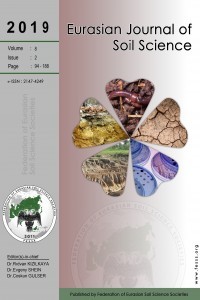
Eurasian Journal of Soil Science
Yazarlar: Tatiana PARAMONOVA, Ekaterina MACHAEVA, Belyaev VLADİMİR
Konular:-
DOI:10.18393/ejss.56716
Anahtar Kelimeler:Radioactive contamination,Caesium-137,Root uptake,Transfer factor,Chernobyl accident
Özet: The estimation of modern parameters of 137Cs root uptake was conducted in natural meadow and agricultural ecosystems of post-Chernobyl landscapes of Tula region. The agrosystems with main crops of field rotation (barley, potatoes, rape, maize) occupying watersheds and slopes with arable chernozems are contaminated at a level 460-670 Bq/kg (4.7-6.0 Ci/km 2); natural meadow ecosystems occupying lower parts of slopes and floodplains are contaminated at a level 620-710 Bq/kg (5.8-7.6 Ci/km 2). In the arable soils 137Cs uniformly distributed to a depth of A p horizon (20-30 cm of thickness), while in meadow soils 70-80% of the radionuclide is concentrated within the top A d horizon (9-13 cm of thickness). These topsoil layer accords with rhizosphere zone, where >80-90% of plant roots are concentrated, and from which 137Cs is mostly consumed by vegetation. Total amount of 137Cs root uptake depends on the level of soil radioactive contamination (correlation coefficient 0.61). So 137Cs activity in meadow vegetation (103-160 Bq/kg) is generally more than one in agricultural vegetation (9-92 Bq/kg). The values of 137Cs transfer factor in the studied ecosystems vary from 0.01 (rape) to 0.20 (wet meadow), that confirms the discrimination of the radionuclide’s root uptake. The larger are the volume of roots and their absorbing surface, the higher are the values of transfer factor from soil to plant (correlation coefficients 0.71 and 0.64 respectively). 137Cs translocation from roots to shoots is also determined by biological features of plants. At the same level of soil contamination above-ground parts of meadow herbs accumulate more 137Cs than Gramineae species, and in agrosystems above-ground parts of weeds concentrate more 137Cs than cultivated cereals. Thus, the level of soil radioactive pollution and biological features of plants are determinants in the process of 137Cs root uptake and translocation and should be considered in land use policy.